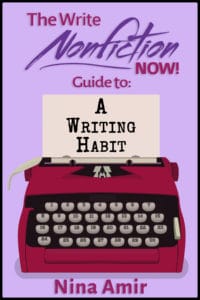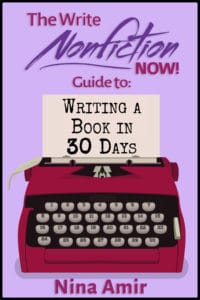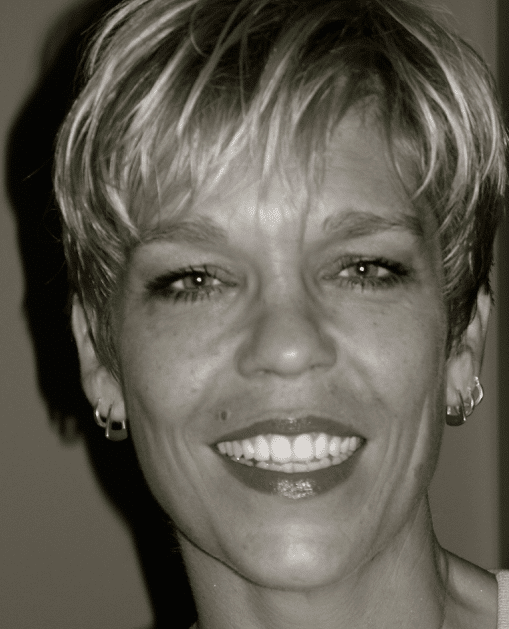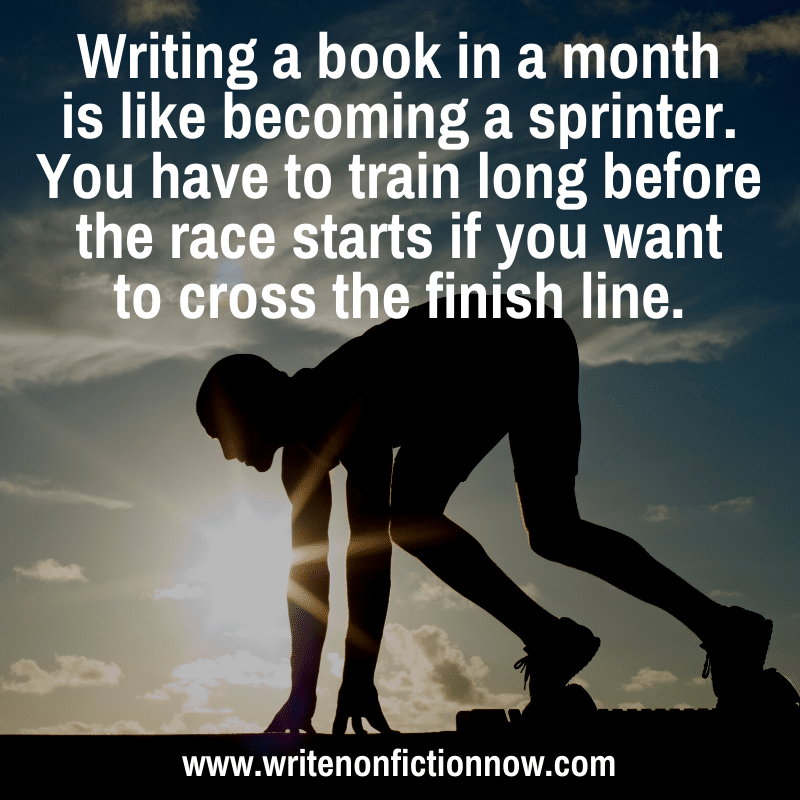If you’re planning to write a nonfiction book in a month, you can’t just turn up on day one and expect to be ready for the challenge. Writing a book in an accelerated timeframe is like running a sprint. You wouldn’t show up at the starting line of a race without a period of training and limbering up first, so why would you show up unprepared for a writing sprint?
The lead-up to a 30-day writing event, like the Write Nonfiction in November (WNFIN) Challenge, aka National Nonfiction Writing Month (NaNonFiWriMo), is a training period. Use that time to get yourself in the right head-space and establish a habit that will maintain your momentum.
This training period is where you can allow yourself to fail. The only way to find out what daily writing approach works with your daily schedule is through a process of elimination. There’s no room in a sprint for trial and error; that’s what your training period is for.
When I tried my first NaNoWriMo event, I was wholly unprepared and gave up on the challenge by the end of the first week. The next year I did a bit of planning but still didn’t see the challenge through to the end. Earlier this year, I wrote my first draft of a nonfiction book in a month, and I just self-published it.
What made the difference? My preparation.
Develop a Writing Habit
To meet your nonfiction writing challenge goals, you’re going to have to write every day. If you miss a day, that increases the pressure to perform on successive days. For example, if you’re planning on writing a 30,000-word first draft within 30 days, your target is 1,000 words a day, but your daily target increases as soon as you miss a day. If you miss too many days, that target will seem unachievable, and you’ll give up.
 Common wisdom says it takes 21 days to create a new habit (some studies say it takes much longer). That means your training period needs to start at least three weeks before you’re due to start your writing sprint. You don’t have to begin by writing 1,000 words a day—you can work up to it over the training period.
Common wisdom says it takes 21 days to create a new habit (some studies say it takes much longer). That means your training period needs to start at least three weeks before you’re due to start your writing sprint. You don’t have to begin by writing 1,000 words a day—you can work up to it over the training period.
Or just use this time to establish a daily writing habit. Simply, write for the same amount of time every day.
Making Time to Write
During this run-up to your writing sprint, you can write anything. It’s not important what you write; you must get words onto a page and train your writing muscles to perform consistently. You also want to develop the mindset and identity that you are someone who writes daily.
Do you know what time of day you’re most productive? Experiment by writing at different times and see which works best for you. I love getting up earlier than usual and starting my day with a writing session. That way, nothing competes for my time, and I’m not trying to juggle other tasks to make room to write.
Before I abandoned my corporate career, I used to write in the cracks of life: A quick writing session before work, half of my lunch hour, stay at work late, squeeze in a writing session while making tea, type on my phone in the coffee or supermarket queue, or swap my gym workout for a power walk around the building while using my voice to text to capture my content.
Discover Your Distractions
It’s easy to find an excuse not to write. There are multiple opportunities throughout the day to write. Still, it’s much less effort to jump onto Facebook or scroll through pretty pictures on Instagram.
By doing trial-and-error experimentation before your writing sprint starts, you can pinpoint your distractions and the time of day when you’ll write successfully. Then block out that time in your calendar.
Don’t obsess about what to write or meeting a daily word count target during this training stage. Just focus on creating a consistent writing habit. This new habit will serve you well when it comes time to write your nonfiction book in a month.
Know What to Write
During this training period, you also want to locate the starting line and determine how to know when you’ve crossed the finish line. For these two things, you need a content map, which will keep you on track.
Writing nonfiction takes planning. You need to know your book’s topic and your content goals. Plus, you need to know your target audience. The more planning you do before your 30-day sprint, the better prepared you’ll be, and the easier it will become to meet your daily word-count target.
There’s nothing more demoralizing to a writer than facing a blank page and having no idea what to write. And doing that often during a 30-day writing sprint is a sure way to fail.
Your Book-in-a-Month Success Plan
However, if you plan out the content for your book’s chapters before you start your sprint, you can use these as your roadmap. Consider these plans a guide, not immovable or set-in-stone.
As you write, other ideas and topics will spring to mind, and you have the flexibility to incorporate new ideas into your project and even cut topics that become irrelevant. But you need to start out with a plan, or else you’ll waste precious time wandering in the creative wilderness. That makes it difficult, if not impossible, to write a nonfiction book in 30 days.
Create a Book Outline
Before I begin a new nonfiction project, I always identify the needs of my target audience. What do they need to know? What fears are they trying to overcome? What goals do they have? What problem are they trying to solve?
 Then I create a book outline that leads them to where they want to go. At a minimum, the first draft of my book outline is a series of chapter headings. More often than not, it also includes a jumble of sub-headings for topics I know I need to cover.
Then I create a book outline that leads them to where they want to go. At a minimum, the first draft of my book outline is a series of chapter headings. More often than not, it also includes a jumble of sub-headings for topics I know I need to cover.
Writing a block of content is much less overwhelming than writing a book. Once I have my chapter headings and sub-headings identified, I use these as my prompts during writing sessions. I don’t have to write them in order, so if the next topic on my list doesn’t inspire me, I pick one further down that does.
I like this approach because I’m cherry-picking the topics that inspire me the most, which helps keep my momentum going. When it’s time to circle back to the topics I’ve skipped, I’m so far into the sprint I’m less likely to abandon my writing challenge. I’ve invested so much time and effort into it that I become determined to finish.
Use your writing time during the 30-day sprint to commit words to a page. Roll the organization and content structuring tasks into the editing phase that follows. But a good plan will make this final step easy.
Overcoming Procrastination or Writer’s Block
Just because you’ve set a writing schedule and know what you need to write doesn’t mean your success is guaranteed. Even with the best plan in the world, you’ll need willpower and motivation to nudge you into the writing zone and help you cross the finish line.
There are a few different techniques you can use to increase your motivation to write. I’ve successfully used meditation to increase my word count and freewriting to clear my writer’s block.
It took me a couple of misstarts to complete my first nonfiction book during a 30-day sprint. If you’ve tried this approach and failed, don’t let that discourage you from trying again. This time, success is within your grasp if you put in the training before the race.
Are you ready to start your writing sprint this November? Let us know what’s standing in your way of writing your nonfiction book in a month. We’ll respond to your comment with our best tips! And, if you found this article inspiring, please share it with your social networks.
About the Author
Jay Art ale abandoned her corporate career to become a digital nomad and full-time writer. She’s an avid blogger and a nonfiction author helping travel writers and travel bloggers achieve their self-publishing goals. Join her at Birds of a Feather Press where she shares tips, advice, and inspiration to writers with an independent spirit.
ale abandoned her corporate career to become a digital nomad and full-time writer. She’s an avid blogger and a nonfiction author helping travel writers and travel bloggers achieve their self-publishing goals. Join her at Birds of a Feather Press where she shares tips, advice, and inspiration to writers with an independent spirit.
 Do you want to learn more about becoming a nonfiction author? Check out the Nonfiction Writers’ University. Get the basic education you need and the coaching to help you succeed as a nonfiction writer. Take advantage of monthly live educational and group coaching events. Enjoy a 30-day trial membership for only $1.
Do you want to learn more about becoming a nonfiction author? Check out the Nonfiction Writers’ University. Get the basic education you need and the coaching to help you succeed as a nonfiction writer. Take advantage of monthly live educational and group coaching events. Enjoy a 30-day trial membership for only $1.
Do you want a more advanced approach to your nonfiction writing education? Join the Nonfiction Writers’ University MASTERS program. Receive ongoing live Certified High Performance Coaching, Author Training, and Authorprenuership Training as well as monthly educational and group coaching events. Learn all the steps to becoming a successful—and profitable—author. Discover how (finally) to write consistently, boldly, enthusiastically, and productively. Develop the mindsets, strategies, habits of the world’s most successful writers. Click here to learn more.
Photo courtesy of romsvetnik.

James Divine says
This is inspiring! Also motivating. I am so glad you have posted this, Nina and Jay.
Nina Amir says
You are welcome! I wish you were doing the WNFIN Prep Program! Hope you take the challenge…and miss you!
Jon Doolan says
Jay Artale talks a whole-lotta truth in this article. I absolutely agree with everything she says, especially all the nifty tricks to make your writing sprint the best ever – get your chapter titles in advance, find your best writing time, identifying and annihilating your distractions, etc. Lots of practical points you can put into action today. I personally have written 3 non-fiction books in 3 consecutive months using the methods she talks about. I’m intrigued by meditation for writing though. That’s a new one I’ll be investigating further. Excellent blog Jay!
Zoe Langley-Wathen says
Thanks Jay, there are some useful pointers in this article. This will be my first 30-day writing sprint and I’m fully aware of my possible obstacles. Distractions – oh yep, big time! Mind wander – I’ll probably head out for a walk when that happens. Staying comfortable – my set-up for writing nowadays isn’t as suited to me as it used to be, before I moved house. Back-ache when blogging has been an issue recently, but I’m working on it!
I do find it useful to have a candle burning when I write and I always use headphones. Sometimes I will play background music through them and other times they’ll remain silent. They seem to help focus my thoughts. 👍 Let’s do this!